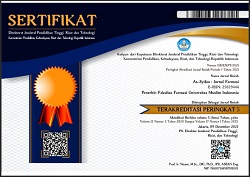UJI AKTIVITAS LARVASIDA PERASAN HERBA SELEDRI (Apium graveolens L.) TERHADAP LARVA Aedes aegypti
Abstract
Keywords
Full Text:
Fulltext PDF (Bahasa Indonesia)References
Kemenkes RI. Profil Kesehatan Indonesia 2014. Jakarta: Kementrian Kesehatan Republik Indonesia, 2015.
Hayani, Eni & Fatimah, Tjitjah. Identifikasi Komponen Kimia dalam Biji Mengkudu (Morinda citrifolia). Prosiding Temu Teknis Nasional Tenaga Fungsional Pertanian Tahun 2004, 2004.
Asikin S. Toksisitas Tumbuhan Jengkol Terhadap Hama Tanaman. Banjarbaru: Badan Penelitian Pertanian Lahan Rawa, 2013.
Aradilla, Ashry S. Uji Aktivitas Larvasida Ekstrak Ethanol Daun Mimba (Azadirachta indica) Terhadap Larva Aedes aegypti (Skripsi). Semarang: Fakultas Kedokteran Universitas Diponegoro, 2009.
Surahman, Mochamad R, Sudibyo S. Metodologi Penelitian Farmasi. Jakarta: Pusat Pengembangan SDM, Kementrian Kesehatan Republik Indonesia, 2016.
Depkes RI. Aedes aegypti Vampir Mini yang Mematikan. Jakarta: Badan Penelitian dan Pengembangan Kesehatan Depkes RI, 2007.
Nurhaifah, Dita & Tri Wahyuni S. Efektivitas Air Perasan Kulit JEruk Manis sebagai Larvasida Nyamuk Aedes aegypti. Jurnal Kesehatan Masyarakat Nasional. 2015;9(3): 209.
Ridha MR, Nisa K. Larva Aedes Aegypti sudah Toleran Terhadap Temepos di Kota Banjarbaru, Kalimantan Selatan. Jurnal Vektora. 2011; 3(2).
Djojosumarto P. Teknik Aplikasi Pestisida Pertanian. Yogyakarta: Kanisius, 2000.
Hasan B, Bambang H, Sri WH, Tri S. Uji Toksisitas Beberapa Ekstrak Tanaman Terhadap Larva Aedes aegypti Vektor Demam Berdarah Dengue. Jurnal Vektora. 2015; 7 (1):29-38.
Putra, Hexy TP. Formulasi dan Uji Efektivitas Sediaan Emulsi Perangsang Pertumbuhan Rambut Ekstrak Seledri (Apium graveolens Linn.) (Skripsi). Bogor: Universitas Pakuan, 2013.
Robinson. Kandungan Organik Tumbuhan Tinggi. Edisi IV. Bandung: ITB, 1995.
Cania ES. Uji Efektivitas Larvasida Ekstrak Daun Legundi (Vitex trifolia) Terhadap Larva Aedes Aegypti. Majorit.2013;2(4):52-60.
Oluremi OI, Ngi J, Andrew IA. Phytonutrients in citrus fruit peel meal and nutritional implication [serial on internet]. Livestock Research for Rural Development. 2007;19(7). Retrieved August 27, 2018, from http://www.lrrd.org/lrrd19/7/olur19089.htm
DOI: https://doi.org/10.56711/jifa.v10i2.346
Refbacks
- There are currently no refbacks.
Indexed by:
ISSN: 2085-4714 | e-ISSN: 2502-9444
Editor's Address:
Faculty of Pharmacy, Univeristas Muslim Indonesia
2nd Campus of UMI: Jl. Urip Sumoharjo km. 5 , Makassar, South Sulawesi, Indonesia
E-mail: jurnal.farmasi@umi.ac.id















